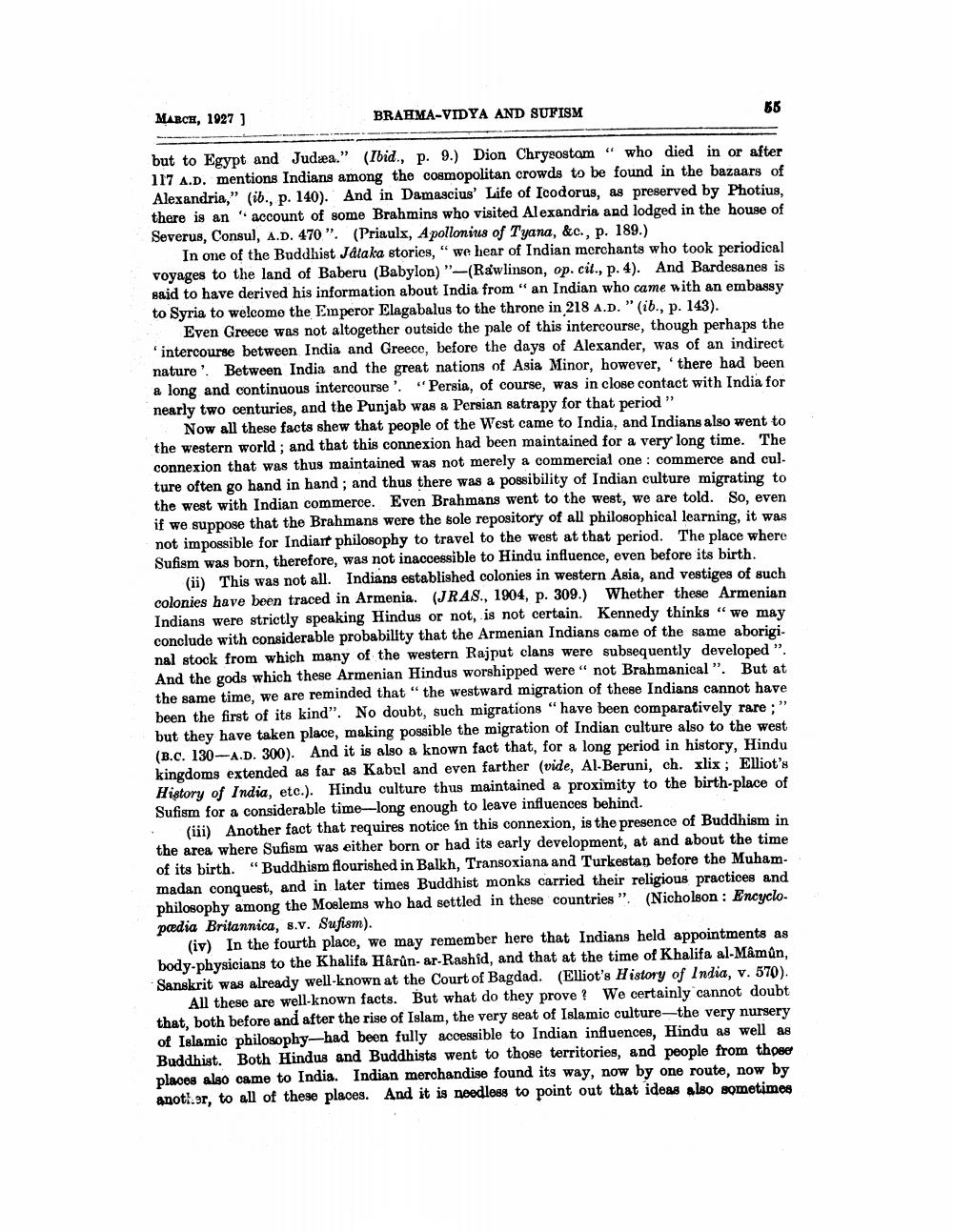________________
MARCE, 1027 ]
BRAHMA-VIDYA AND SUFISM
but to Egypt and Judæa." (Ibid., p. 9.) Dion Chrysostom" who died in or after 117 A.D. mentions Indians among the cosmopolitan crowds to be found in the bazaars of Alexandria," (ib., p. 140). And in Damascius' Life of Icodorus, as preserved by Photius, there is an account of some Brahmins who visited Alexandria and lodged in the house of Severus, Consul, A.D. 470". (Priauls, Apollonius of Tyana, &c., p. 189.)
In one of the Buddhist Jataka stories, "we hear of Indian merchants who took periodical voyages to the land of Baberu (Babylon) -(Rawlinson, op. cit., p. 4). And Bardesanes is said to have derived his information about India from " an Indian who came with an embassy to Syria to welcome the Emperor Elagabalus to the throne in 218 A.D." (ib., p. 143).
Even Greece was not altogether outside the pale of this intercourse, though perhaps the intercourse between India and Greece, before the days of Alexander, was of an indirect nature. Between India and the great nations of Asia Minor, however, there had been a long and continuous intercourse'. "Persia, of course, was in close contact with India for nearly two centuries, and the Punjab was a Persian satrapy for that period”
Now all these facts shew that people of the West came to India, and Indians also went to the western world, and that this connexion had been maintained for a very long time. The connexion that was thus maintained was not merely a commercial one : commerce and cul. ture often go hand in hand; and thus there was a possibility of Indian culture migrating to the west with Indian commerce. Even Brahmans went to the west, we are told. So, even if we suppose that the Brahmans were the sole repository of all philosophical learning, it was not impossible for Indiart philosophy to travel to the west at that period. The place where Sufism was born, therefore, was not inaccessible to Hindu influence, even before its birth.
(ii) This was not all. Indians established colonies in western Asia, and vestiges of such colonies have been traced in Armenia. (JRAS., 1904, p. 309.) Whether these Armenian Indians were strictly speaking Hindus or not, is not certain. Kennedy thinks we may conclude with considerable probability that the Armenian Indians came of the same aboriginal stock from which many of the western Rajput clans were subsequently developed ”. And the gods which these Armenian Hindus worshipped were" not Brahmanical". But at the same time, we are reminded that "the westward migration of these Indians cannot have been the first of its kind". No doubt, such migrations "have been comparatively rare ;" but they have taken place, making possible the migration of Indian culture also to the west (B.C. 130-A.D. 300). And it is also a known fact that, for a long period in history, Hindu kingdoms extended as far as Kabel and even farther (vide, Al-Beruni, ch. xlix ; Elliot's History of India, etc.). Hindu culture thus maintained a proximity to the birth-place of Sufism for a considerable time-long enough to leave influences behind.
(iii) Another fact that requires notice in this connexion, is the presence of Buddhism in the area where Sufism was either born or had its early development, at and about the time of its birth. “Buddhism flourished in Balkh, Transoxiana and Turkestan before the Muham. madan conquest, and in later times Buddhist monks carried their religious practices and philosophy among the Moslems who had settled in these countries" (Nicholson : Encyclo. pædia Britannica, s.v. Sufism).
(iv) In the fourth place, we may remember here that Indians held appointments as body-physicians to the Khalifa Harun-ar-Rashid, and that at the time of Khalifa al-Mâmun, Sanskrit was already well-known at the Court of Bagdad. (Elliot's History of India, v. 570).
All these are well-known facts. But what do they prove? We certainly cannot doubt that, both before and after the rise of Islam, the very seat of Islamic culture-the very nursery of Islamic philosophy-had been fully accessible to Indian influences, Hindu as well as Buddhist. Both Hindus and Buddhists went to those territories, and people from those places also came to India. Indian merchandise found its way, now by one route, now by another. to all of these places. And it is needless to point out that ideas also sometimes




